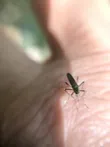Harmful Effects of Woodland Pool Mosquito
A species of Mosquito
Woodland Pool Mosquito can pose health risks through bites during their adult stage, primarily for blood meals necessary for egg development. Bites may result in mild itching and swelling, but are not typically life-threatening. Transmission of diseases is not indicated, and the risk of severe health issues is low.
Does the Woodland Pool Mosquito bite humans or animals?
Harmful Facts About Woodland Pool Mosquito
What Type of Pest Is Woodland Pool Mosquito?









AI entomologist in your pocket
Scan QR code to download

